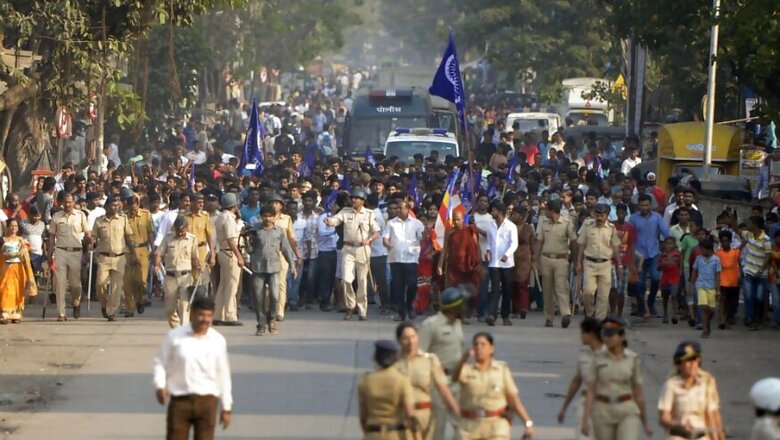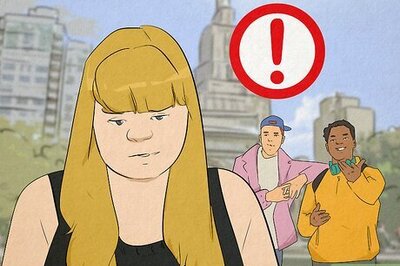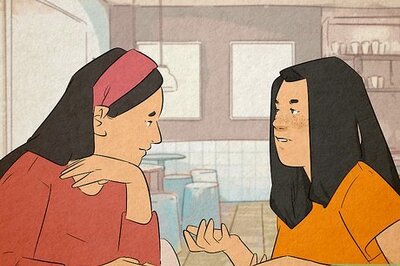
views
January 1, 2018, will go down as a significant moment in the history of Dalit movement in India. For on that day, Maharashtra once again witnessed the Ambedkarite movement in full rigour, reminding observers that their obituaries were premature.
A day after violence erupted at a peaceful gathering of Dalits at Bhima-Koregaon to commemorate the 200th anniversary of the epic 1818 battle, the state government lost no time in rounding up Dalit protesters. More than 1,000 people were arrested in a day, leading to the Devendra Fadnavis government being branded ‘modern Peshwai’ by liberal thinkers.
Parallels were drawn between the Peshwa rule, notorious for caste-based oppression, and the BJP government. Dalit thinkers pointed out that Right-wing leader Milind Ekbote was granted bail and no efforts were made to arrest Hindutva leader Sambhaji Bhide, who allegedly orchestrated the violence in which one person was killed.
Raja Dhale, a founding member of Dalit Panthers, a radical outfit active in the 1970s in Maharashtra, said nothing had since the battle of Bhima-Koregaon 200 years ago. “… 200 years later, is democracy for everyone? Have we (Dalits) been really integrated into the society? The answer is no,” he told Indian Express in an interview.
Dhale questions not just the political supremacy of the upper caste, but also the continuity of socio-cultural impunity against Dalits.
To such concerns, Sambhaji Bhide, a former RSS worker and founder of Shiv Pratishthan Hindustan, parrots the misplaced upper caste fears over the misuse of the Scheduled Castes and the Scheduled Tribes (Prevention of Atrocities) Act. “Democracy has come to an end… By giving the Atrocity Act to one community (Dalits), we have brought about abject humiliation to the Constitution and democracy,” he had said at a gathering.
Making such statements since his alleged role in last year’s violence, Bhide has tapped into the fears of the upper caste, seemingly gathering support from sections anxious over the Prevention of Atrocities Act.
Since Bhide was seen as close to the ruling BJP, it was more or less assumed that he would walk. CM Devendra Fadnavis’ statements added fuel to fire. The CM first reduced the violence to “mere clashes between two groups because of a misunderstanding”. He then claimed there was no evidence to show that Bhide was directly involved.
Prakash Ambedkar, the chief of the Bharip Bahujan Mahasangh, however, contested this apparent clean chit to Bhide, saying social media has enough proof on Bhide’s involvement.
While the BJP’s soft approach towards those accused of the violence has been attributed by opposition parties to its “anti-Dalit” mindset, anti-caste thinkers view this as a conflict between two ideologies -- Brahmanism and Ambekarism. It is in this context that Dr Sukumar, an Ambedkarite ideologue and professor at Delhi University, wrote: “A culture that celebrates Dronacharya, eliminates Shambuka and relegates Eklayva to the margins, would not tolerate the Dalits’ slice of military victory”.
According to Kancha Ilaiah Shepherd, last year’s commemoration at Bhima-Koregaon was a symbol of a larger unity among Dalits, OBCs and Muslims.
Since anti-caste movements expose the violent reality of caste discrimination and rebuffed the imagined socio-cultural unity among Indians, it has often being stigmatised and criminalised by the upper caste society. History repeated itself when Dalit activists who were protesting against the attack on the peaceful crowd at Bhima-Koregan were themselves branded as ‘urban Maoists’.
Ambedkar’s Samata Sanik Dal, an organisation founded after the Mahad Chavdar Tale Satyagrah, also had to face similar accusations from the upper caste society, following which Ambedkar himself dismissed the allegations as “foul” and “venomous” in several of his speeches.
In the post-Ambedkar era, movements like the Dalit Panthers were also branded violent and disruptive. Dalit protests have always been judged by the moralistic gaze of the upper caste. On the one hand, Right-wing upper caste groups castigated such movements as ‘spoilers’ to their imagined and so-called ‘social fabric’ of India, while the Left-leaning and liberal upper caste groups saw them with contempt and labelled it as ‘identity politics’.
Significantly, the protests that followed the Bhima-Koregaon violence received support from caste and religious groups opposed to the BJP; groups that were not necessarily pro-Dalits and from the predominantly upper caste opposition parties like the Congress, the NCP and the Left.
The violence and the developments that followed also led to a churning in the Dalit movement in general and Dalit politics in particular in Maharashtra. Dalits once again started reorganising themselves by taking part in protests. At a political level, Prakash Ambedkar emerged as the Dalits’ ‘own leader’ who negotiate a better deal for the community when it comes to sharing political power. Dalit movements had for long been suffering from lack of active leadership.
Although, the BSP filled the political vacuum for some years, it failed to create a strong Dalit leadership in Maharashtra. That vacuum is now being filled by Prakash Ambedkar. It’s a sign that though Dalit politics in Maharashtra is fractured and conditional, the socio-cultural movement at the grassroots has intensified, and that unlike other states, Dalits can make Maharashtra sit up and take notice of their questions.
(The Writer is a BAPSA activist and JNU research scholar. The views expressed are personal)

















Comments
0 comment